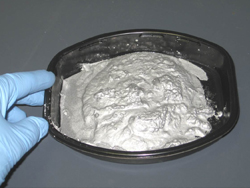Acetone has many uses in industry as well as everyday use. An effective solvent and cleaner, acetone is also widely used as a drying agent. As effective as it is however, the use of acetone drying agent requires a thorough understanding of its unique qualities.
When subjected to an oxidization process, acetone results in a byproduct known as acetone peroxide. A highly unstable compound, acetone peroxide can even result accidentally when hydrogen peroxide is inadvertently mixed with acetone drying agent during improper waste disposal.
Acetone peroxide is a highly combustible substance—even more so than acetone drying agent and it is even more sensitive to friction and shock than nitroglycerin. Because of its inherent instability, acetone peroxide is almost never used in commercial applications even though it is quite easy to produce.
Despite its chemical properties, acetone drying agent does not have carcinogenic properties. It also does not have any neurotoxic effects.
Back to Top
Characteristics and alternative names of acetone
Acetone is known by several names including:- propanone
- dimethyl ketone
- 2-propanone
- propan-2-one
- β-ketopropane
Uses of acetone
One of the most common uses of acetone is as a drying agent, although it has many other uses as well. Acetone is also often used as an effective solvent, since it has the ability to react chemically with a wide variety of organic compounds. Acetone is also commonly used in the manufacturing of plastic, fiber, drugs, and various chemicals, and it is the primary ingredient in nail polish remover.Safety issues associated with acetone use
Because acetone is so flammable, extreme caution must be taken when using an acetone drying agent for whatever purpose. When acetone is subjected to temperatures higher than its flash point of −20 °C, it may explode or ignite. This can occur even with as little as 2.5% acetone in an acetone mixture containing air. The acetone vapors may also flow along an object’s surfaces to an ignition source located a considerable distance away, and then flash back to its origin. An acetone drying agent may even be ignited by a static discharge, and it will spontaneously ignite at temperatures from 465 °C.When subjected to an oxidization process, acetone results in a byproduct known as acetone peroxide. A highly unstable compound, acetone peroxide can even result accidentally when hydrogen peroxide is inadvertently mixed with acetone drying agent during improper waste disposal.
Acetone peroxide is a highly combustible substance—even more so than acetone drying agent and it is even more sensitive to friction and shock than nitroglycerin. Because of its inherent instability, acetone peroxide is almost never used in commercial applications even though it is quite easy to produce.
Health issues with acetone drying agents
Based on extensive clinical testing, it was discovered that acetone actually has relatively low toxicity when inhaled or even ingested by humans. Inhaling high concentrations of the substance (approximately 9200 ppm) can cause significant throat irritation in as little as a few minutes. When inhaled at a concentration of 1000 ppm, a 1 hour long exposure will cause eye and throat irritation. However, subjects exposed to 500 ppm of acetone for over a two hour period displayed no symptoms at all.Despite its chemical properties, acetone drying agent does not have carcinogenic properties. It also does not have any neurotoxic effects.
Back to Top
Drying Agent

Drying Agent Resources
Sponsored Links
